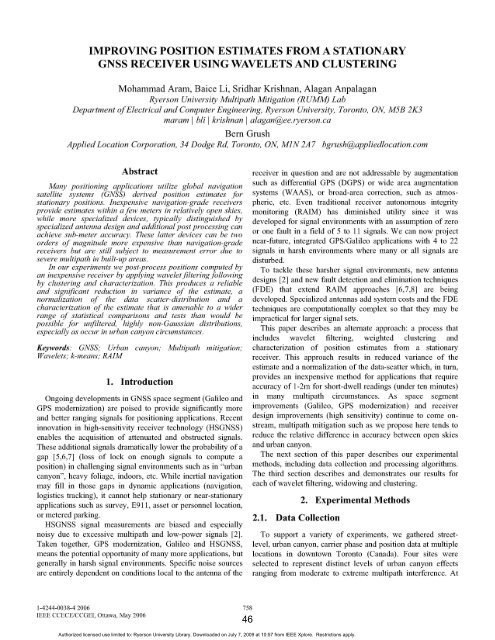Signal Analysis Research (SAR) Group - RNet - Ryerson University
Signal Analysis Research (SAR) Group - RNet - Ryerson University
Signal Analysis Research (SAR) Group - RNet - Ryerson University
Create successful ePaper yourself
Turn your PDF publications into a flip-book with our unique Google optimized e-Paper software.
IMPROVING POSITION ESTIMATES FROM A STATIONARY<br />
GNSS RECEIVER USING WAVELETS AND CLUSTERING<br />
Mohammad Aram, Baice Li, Sridhar Krishnan, Alagan Anpalagan<br />
<strong>Ryerson</strong> <strong>University</strong> Multipath Mitigation (RUMM) Lab<br />
Department ofElectrical and Computer Engineering, <strong>Ryerson</strong> <strong>University</strong>, Toronto, ON, M5B 2K3<br />
maram bli krishnan alagan@ee.ryerson.ca<br />
Bern Grush<br />
Applied Location Corporation, 34 Dodge Rd, Toronto, ON, M1N 2A 7 bgrush@appliedlocation.com<br />
Abstract<br />
Many positioning applications utilize global navigation<br />
satellite systems (GNSS) derived position estimates for<br />
stationary positions. Inexpensive navigation-grade receivers<br />
provide estimates within a few meters in relatively open skies,<br />
while more specialized devices, typically distinguished by<br />
specialized antenna design and additional post processing can<br />
achieve sub-meter accuracy. These latter devices can be two<br />
orders of magnitude more expensive than navigation-grade<br />
receivers but are still subject to measurement error due to<br />
severe multipath in built-up areas.<br />
In our experiments we post-process positions computed by<br />
an inexpensive receiver by applying waveletfilteringfollowing<br />
by clustering and characterization. This produces a reliable<br />
and significant reduction in variance of the estimate, a<br />
normalization of the data scatter-distribution and a<br />
characterization of the estimate that is amenable to a wider<br />
range of statistical comparisons and tests than would be<br />
possible for unfiltered, highly non-Gaussian distributions,<br />
especially as occur in urban canyon circumstances.<br />
Keywords. GNSS; Urban canyon; Multipath mitigation;<br />
Wavelets; k-means; RAIM<br />
1. Introduction<br />
Ongoing developments in GNSS space segment (Galileo and<br />
GPS modernization) are poised to provide significantly more<br />
and better ranging signals for positioning applications. Recent<br />
innovation in high-sensitivity receiver technology (HSGNSS)<br />
enables the acquisition of attenuated and obstructed signals.<br />
These additional signals dramatically lower the probability of a<br />
gap [5,6,7] (loss of lock on enough signals to compute a<br />
position) in challenging signal environments such as in "urban<br />
canyon", heavy foliage, indoors, etc. While inertial navigation<br />
may fill in those gaps in dynamic applications (navigation,<br />
logistics tracking), it cannot help stationary or near-stationary<br />
applications such as survey, E9 11, asset or personnel location,<br />
or metered parking.<br />
HSGNSS signal measurements are biased and especially<br />
noisy due to excessive multipath and low-power signals [2].<br />
Taken together, GPS modernization, Galileo and HSGNSS,<br />
means the potential opportunity of many more applications, but<br />
generally in harsh signal environments. Specific noise sources<br />
are entirely dependent on conditions local to the antenna of the<br />
1-4244-0038-4 2006 7758<br />
IEEE CCECE/CCGEI, Ottawa, May 2006<br />
46<br />
receiver in question and are not addressable by augmentation<br />
such as differential GPS (DGPS) or wide area augmentation<br />
systems (WAAS), or broad-area correction, such as atmospheric,<br />
etc. Even traditional receiver autonomous integrity<br />
monitoring (RAIM) has diminished utility since it was<br />
developed for signal environments with an assumption of zero<br />
or one fault in a field of 5 to 11 signals. We can now project<br />
near-future, integrated GPS/Galileo applications with 4 to 22<br />
signals in harsh environments where many or all signals are<br />
disturbed.<br />
To tackle these harsher signal environments, new antenna<br />
designs [2] and new fault detection and elimination techniques<br />
(FDE) that extend RAIM approaches [6,7,8] are being<br />
developed. Specialized antennas add system costs and the FDE<br />
techniques are computationally complex so that they may be<br />
impractical for larger signal sets.<br />
This paper describes an alternate approach: a process that<br />
includes wavelet filtering, weighted clustering and<br />
characterization of position estimates from a stationary<br />
receiver. This approach results in reduced variance of the<br />
estimate and a normalization of the data-scatter which, in turn,<br />
provides an inexpensive method for applications that require<br />
accuracy of 1-2m for short-dwell readings (under ten minutes)<br />
in many multipath circumstances. As space segment<br />
improvements (Galileo, GPS modernization) and receiver<br />
design improvements (high sensitivity) continue to come onstream,<br />
multipath mitigation such as we propose here tends to<br />
reduce the relative difference in accuracy between open skies<br />
and urban canyon.<br />
The next section of this paper describes our experimental<br />
methods, including data collection and processing algorithms.<br />
The third section describes and demonstrates our results for<br />
each of wavelet filtering, widowing and clustering.<br />
2.1. Data Collection<br />
2. Experimental Methods<br />
To support a variety of experiments, we gathered streetlevel,<br />
urban canyon, carrier phase and position data at multiple<br />
locations in downtown Toronto (Canada). Four sites were<br />
selected to represent distinct levels of urban canyon effects<br />
ranging from moderate to extreme multipath interference. At<br />
Authorized licensed use limited to: <strong>Ryerson</strong> <strong>University</strong> Library. Downloaded on July 7, 2009 at 10:57 from IEEE Xplore. Restrictions apply.


